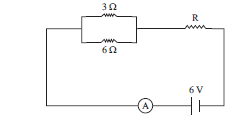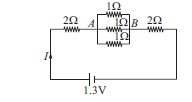Refer to CBSE Class 10 Physics Electricity MCQs Set E provided below available for download in Pdf. The MCQ Questions for Class 10 Science with answers are aligned as per the latest syllabus and exam pattern suggested by CBSE, NCERT and KVS. Chapter 11 Electricity Class 10 MCQ are an important part of exams for Class 10 Science and if practiced properly can help you to improve your understanding and get higher marks. Refer to more Chapter-wise MCQs for CBSE Class 10 Science and also download more latest study material for all subjects
MCQ for Class 10 Science Chapter 11 Electricity
Class 10 Science students should refer to the following multiple-choice questions with answers for Chapter 11 Electricity in Class 10.
Chapter 11 Electricity MCQ Questions Class 10 Science with Answers
Question: In house electrical circuits the fuse wire for safety should be of
a) High resistance – high melting point
b) Low resistance – high melting point
c) Low resistance – low melting point
d) High resistance – low melting point
Answer: d
Question: Work of 14 J is done to move 2 C charge between two points on a conducting wire. What is the potential difference between the two points?
a) 28 V
b) 14 V
c) 7 V
d) 3.5 V
Answer: c
Question: If the resistance of a certain copper wire is 1 Ω, then the resistance of a similar nichrome wire will be about:
a) 25 Ω
b) 30 Ω
c) 60 Ω
d) 45 Ω
Answer: c
Question: An electric toaster has a power rating of 200 W. It operates for 1 hour in the morning and 1 hour in the evening. How much does it cost to operate the toaster for 10 days at Rs 5 per kW h?
a) Rs 20
b) Rs 400
c) Rs 5000
d) Rs 10000
Answer: a
Question: Power dissipated across the 8Ω resistor in the circuit shown here is 2 watt. The power dissipated in watt units across the 3Ω resistor is

a) 1.0
b) 0.5
c) 3.0
d) 2.0
Answer: c
Question: If the diameter of a resistance wire is halved, then its resistance becomes:
a) four times
b) half
c) one-fourth
d) two times
Answer: a
Question: Two devices are connected between two points, say A and B in parallel. The physical quantity that will remain the same between the two points is
a) current
b) voltage
c) resistance
d) None of these
Answer: b
Question: Keeping the potential difference constant, the resistance of a circuit is doubled. The current will become:
a) double
b) half
c) one-fourth
d) four times
Answer: b
Question: An electrical appliance has a resistance of 25 Ω. When this electrical appliance is connected to a 230 V supply line, the current passing through it will be:
a) 0.92 A
b) 2.9 A
c) 9.2 A
d) 92 A
Answer: c
Question: A heater coil is cut into two equal parts and only one part is used in the heater, the heat generated now will be
a) doubled
b) four times
c) one fourth
d) halved
Answer: a
Question: In the circuit diagram shown below, VA and VB are the potentials at points A and B respectively. Then, VA – VB is
a) –10 V
b) –20 V
c) 0 V
d) 10 V
Answer: d
Question: A student in a town in India, where the price per unit (1 unit = 1 kW-hr) of electricity is ₹5.00, purchases a 1 kVA UPS. If 10 laptops of 90W each run on it for 5 hours, which statements are true?
a) I only
b) I and II only
c) I and III only
d) II and III only
Answer: c
Question: The diameter of a wire is reduced to one-fifth of its original value by stretching it. If its initial resistance is R, what would be its resistance after reduction?
a) R/625
b) R/25
c) 25R
d) 625R
Answer: d
Question: What is the equivalent resistance of the following arrangement between M and N
a) R/2
b) R/3
c) R/4
d) R/6
Answer: b
Question: A student performing Ohm’s law experiment puts the voltmeter and the ammeter as shown incorrectly. The reading in the voltmeter will be close to
a) 0 V
b) 4.8 V
c) 6.0 V
d) 1.2 V
Answer: c
Question: A wire of resistance R is bent to form a square ABCD. What is the effective resistance between E (mid-point of CD) and C?
a) R
b) 7/64 R
c) 3/4 R
d) 1/16 R
Answer: b
Question: Which of the following acts as a circuit protection device?
a) conductor
b) inductor
c) switch
d) fuse
Answer: d
Question: In a circuit, the ammeter is always connected in series and voltmeter in parallel. This arrangement is used in
a) Ammeter is in parallel, voltmeter is in series
b) Both ammeter and voltmeter are in parallel
c) Ammeter is in series, voltmeter is in parallel
d) Both ammeter and voltmeter are in series
Answer: c
Question: From a power station, the power is transmitted at a very high voltage because –
a) it is generated only at high voltage
b) it is cheaper to produce electricity at high voltage
c) electricity at high voltage is less dangerous
d) there is less loss of energy in transmission at high voltage
Answer: d
Question: The resistance of a wire is ‘R’ ohm. If it is melted and stretched to ‘n’ times its original length, its new resistance will be:
a) R/n
b) n²R
c) R/n²
d) nR
Answer: b
Question: What is the current supplied by the battery in the circuit shown? Each resistance is 1 kΩ and potential difference VAB = 8 V.
a) 64 mA
b) 15 mA
c) 9.87 mA
d) 1 mA
Answer: b
Question: If the ammeter in the given circuit reads 2 A, what is the value of resistance R (resistance of ammeter is negligible)?

a) 1 Ω
b) 2 Ω
c) 3 Ω
d) 4 Ω
Answer: a
Question: Two electric bulbs rated P1 watt V volts and P2 watt V volts are connected in parallel across V volts. The total power will be:
a) P1 + P2
b) √(P1 × P2)
c) (P1 × P2)/(P1 + P2)
d) (P1 + P2)/(P1 × P2)
Answer: a
Question: The resistance of a wire is R. After melting it is remoulded such that its area of cross section becomes n times its initial area. Its new resistance will be:
a) nR
b) R/n
c) n2R
d) R/n2
Answer: d
Question: The resistance of a wire is R. After melting it is remoulded to increase its length to n times the original. What is the new resistance?
a) R/n
b) n²R
c) R/n²
d) nR
Answer: b
Question: A copper wire is stretched to make it 0.5% longer. The percentage change in its electrical resistance, assuming volume is constant, is:
a) 2.0%
b) 2.5%
c) 1.0%
d) 0.5%
Answer: c
Question: In a circuit, the ratio of work done by the battery to maintain the current between point A and B to the work done for the whole circuit is:

a) 1/117
b) 1/13
c) 1/12
d) 1
Answer: b
Question: Three electric bulbs of rating 40W–200V, 50W–200V and 100W–200V are connected in series to a 600V supply. What happens as the supply is switched on?
a) Only 50W bulb will fuse
b) Both 40W and 50W bulbs will fuse
c) All bulbs emit light with their rated powers
d) 100W bulb will emit light of maximum intensity
Answer: b
Question: Across a metallic conductor of non-uniform cross-section, a constant potential difference is applied. Which quantity remains constant?
a) current
b) drift velocity
c) electric field
d) current density
Answer: a
Question: Six similar bulbs are connected as shown in the figure with a DC source of emf E, and zero internal resistance. The ratio of power consumption by the bulbs when (i) all are glowing and (ii) in the situation when two from section A and one from section B are glowing, will be:

a) 4 : 9
b) 9 : 4
c) 1 : 2
d) 2 : 1
Answer: b
Question: An electric bulb is rated 220V and 100W. When it is operated on 110V, the power consumed will be
a) 100W
b) 75W
c) 50W
d) 25W
Answer: d
in the following blanks with suitable words :
Question: An electric bulb is rated at 220 V, 100 W. What is its resistance ?
Answer: 484 Ω
Question: If the current passing through a conductor is doubled, what will be the change in heat produced ?
Answer: Heat produced becomes four times
Question: Which one has a higher electrical resistance : a 100 watt bulb or a 60 watt bulb ?
Answer: 60 watt bulb
Question: A potential difference of 20 volts is applied across the ends of a resistance of 5 ohms. What current will flow in the resistance ?
Answer: 4 A
Question: Copper is a good…………….Plastic is an……………….
Answer: conductor ; insulator
Question: What current will be taken by a 920 W appliance if the supply voltage is 230 V ?
Answer: 4 A
Question: Keeping the potential difference constant, the resistance of a circuit is halved. By how much does the current change ?
Answer: Current becomes double
Question: A resistance of 20 ohms has a current of 2 amperes flowing in it. What potential difference is there between its ends ?
Answer: 40 V
Question: A current of 5 amperes flows through a wire whose ends are at a potential difference of 3 volts. Calculate the resistance of the wire.
Answer: 0.6 Ω
Question: Name the physical quantity whose unit is “ohm”.
Answer: Electrical resistance
Question: Potential difference is measured in …………..by using a ………………placed in……………across a component.
Answer: One volts ; voltmeter ; parallel
Question: What is the general name of the substances having infinitely high electrical resistance ?
Answer: Insulators
Question: Name the law which relates the current in a conductor to the potential difference across its ends.
Answer: Ohm’s law
MCQs for Chapter 11 Electricity Science Class 10
Expert teachers of studiestoday have referred to NCERT book for Class 10 Science to develop the Science Class 10 MCQs. If you download MCQs with answers for the above chapter you will get higher and better marks in Class 10 test and exams in the current year as you will be able to have stronger understanding of all concepts. Daily Multiple Choice Questions practice of Science will help students to have stronger understanding of all concepts and also make them expert on all critical topics. After solving the questions given in the MCQs which have been developed as per latest books also refer to the NCERT solutions for Class 10 Science. We have also provided lot of MCQ questions for Class 10 Science so that you can solve questions relating to all topics given in each chapter. After solving these you should also refer to Class 10 Science MCQ Test for the same chapter.
You can download the CBSE MCQs for Class 10 Science Chapter 11 Electricity for latest session from StudiesToday.com
Yes, the MCQs issued by CBSE for Class 10 Science Chapter 11 Electricity have been made available here for latest academic session
You can find CBSE Class 10 Science Chapter 11 Electricity MCQs on educational websites like studiestoday.com, online tutoring platforms, and in sample question papers provided on this website.
To prepare for Chapter 11 Electricity MCQs, refer to the concepts links provided by our teachers and download sample papers for free.
Yes, there are many online resources that we have provided on studiestoday.com available such as practice worksheets, question papers, and online tests for learning MCQs for Class 10 Science Chapter 11 Electricity

